市场资讯及洞察
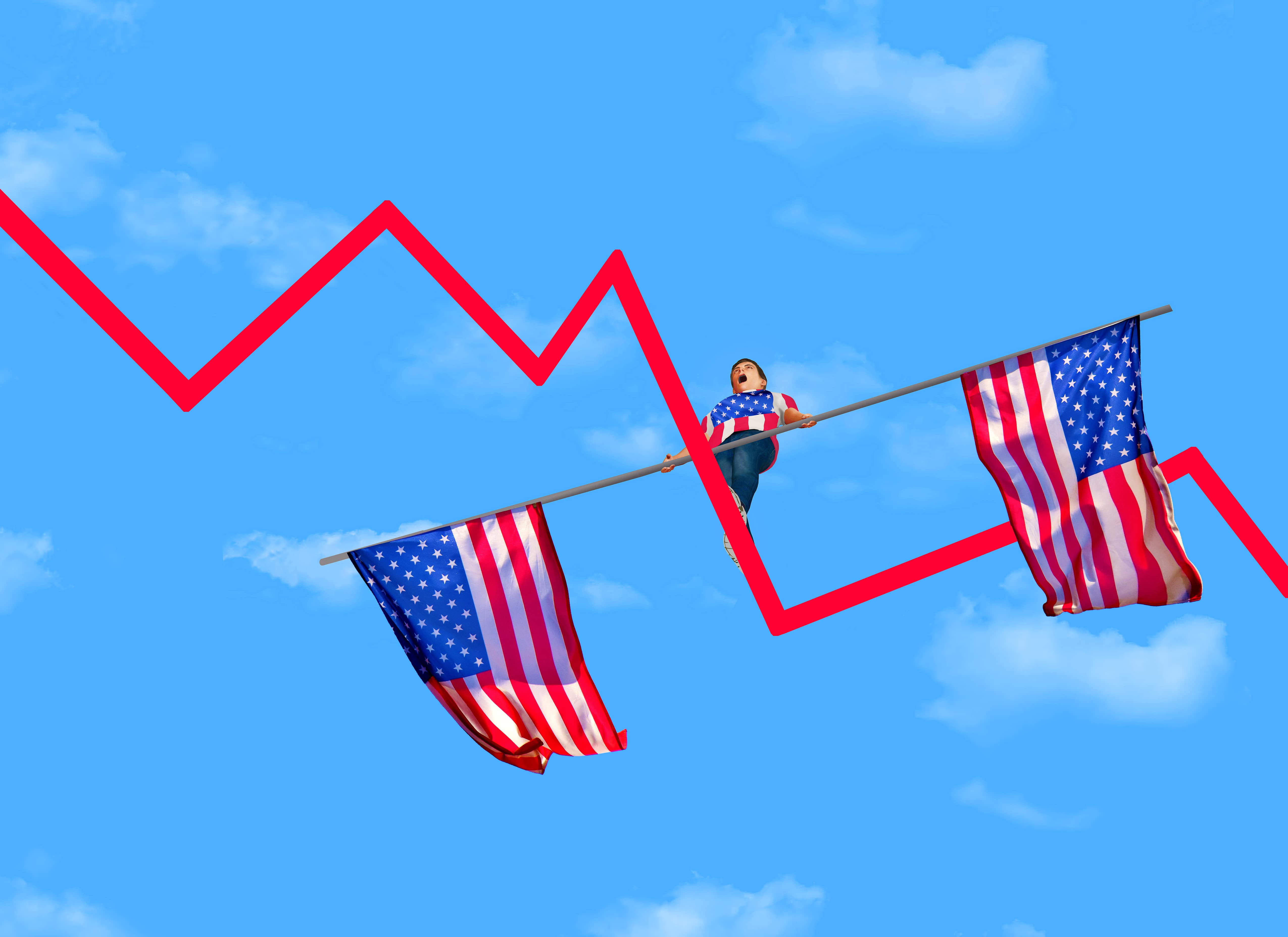
The longest government shutdown in US history has finally ended after 42 long days.
After a month and a half of political theatre, seven Democrats and one independent broke ranks and voted with Republicans to pass a stopgap measure. The Senate went 60-40, the House followed 222-209, and Trump signed it hours later.
The legislation includes three-year appropriations for the Agriculture Department, FDA, military construction, veterans affairs, and congressional operations, along with restoration of pay for federal workers and reversal of Trump administration layoffs through January.
However, the most contentious issue, healthcare subsidies, has been kicked down the road to a December Senate vote.

COVID-era ACA subsidies expire at year-end. When they do, premiums for the average subsidised household will more than double from $888 to $1,904 per year, with an estimated 3.8 million people losing coverage entirely.
If the December vote fails, which is likely considering how far apart the two parties are on the topic, we could see a new shutdown begin in January.
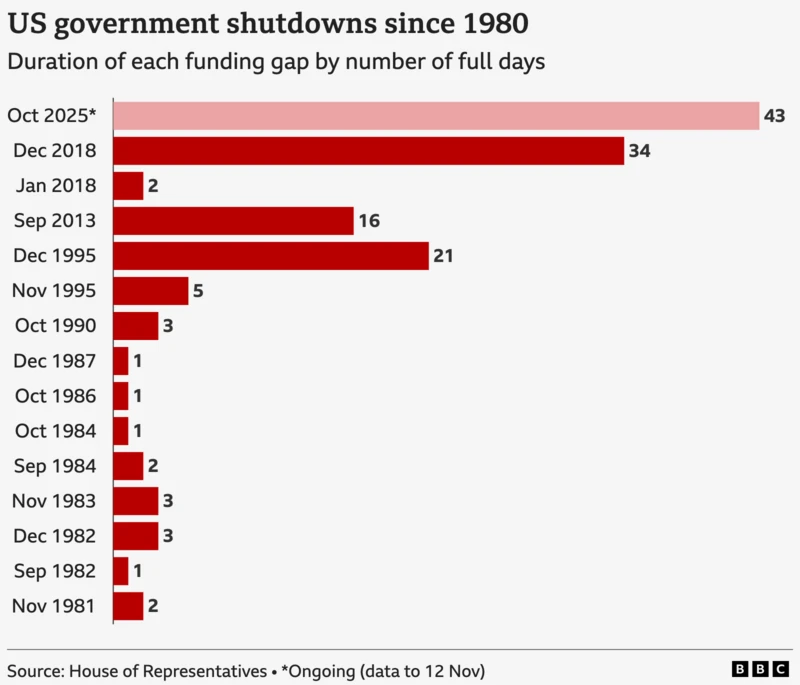
What Happens Next?
This Week:
- Federal employees return to work.
- Paychecks start flowing again.
- SNAP benefits get restored for 42 million people, though heating assistance won't come back for weeks.
- National parks reopen.
- Airports start to go back to normal.
December:
- Senate votes on healthcare subsidies. It will probably fail.
- Premium notices continue to be sent showing 2026 costs doubling.
January 30:
- Government funding expires.
- We do this whole thing over, except now the healthcare subsidies have already expired.
- If Republicans and Democrats remain divided on budget priorities, another shutdown will likely begin.
By the Numbers:
Over the past 42 days, approximately 750,000 federal workers have been furloughed. Another two million worked without pay. Over 42 million had their food assistance delayed. And the FAA cut flights by 10% because air traffic controllers stopped showing up to work.
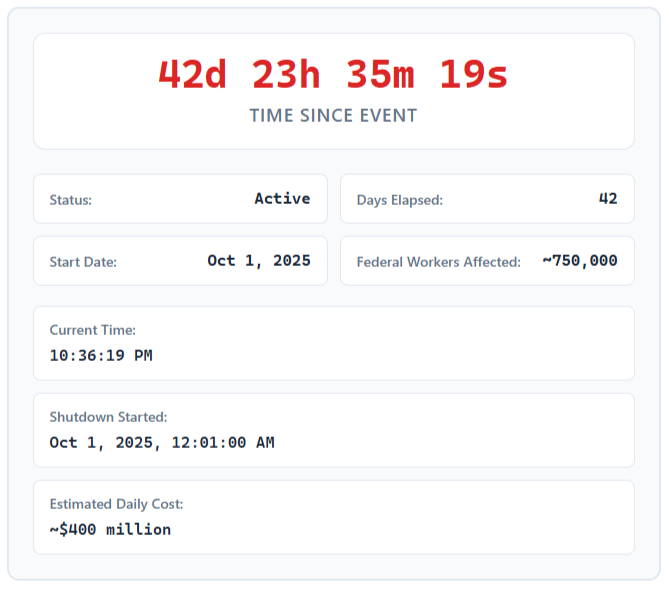
Further concern is the "data blackout" that has hampered Federal Reserve decision-making. Key economic indicators, including jobs reports, were suspended, leaving the Fed blind during an active rate-cutting cycle.
Meanwhile, separate analyses from Challenger, Gray & Christmas showed layoffs surged 183% in October, which would make it the worst October for jobs since 2003.
The Bottom Line
Today’s deal ended the shutdown, but it didn’t actually solve anything. The deal essentially kicks the can down the road to January while leaving the healthcare crisis unresolved.
With both parties divided on healthcare and spending priorities, and Trump lacking a comprehensive plan to address rising premiums and high deductibles, a resolution in the December vote seems unlikely.
If no compromise is accepted by the time Government funding expires on January 30, another shutdown is almost inevitable.
Impact of Australian Jobs Reports and U.S. Shutdown End on the Aussie


Equity markets US markets dipped last night with the Dow finishing down for the first time in 4 sessions. This came as the streak of better-than-expected economic data came to an end with initial jobless claims unexpectedly jumping to a one-month high last week. Retail giant and Dow 30 component Walmart (WMT) also weighed on the index dropping 6.5 per cent after it missed quarterly profit estimates and predicted a low-single digit rise in fiscal 2022 net sales.
Source: Yahoo Finance Whilst US Markets are flat for the week, UK and Asian equity markets have performed well with signs of China's economic recovery continuing lifting the Hang Seng and good news on UK vaccination progress sending the FTSE 100 higher. Source: Bloomberg The ASX200 again hit post COVID highs this week before pulling back slightly. Optimism in the Australian economic recovery was bolstered this week with another drop in the unemployment rate and vaccine rollouts imminent.
Forex markets FX markets were mixed this week, the US dollar strengthened modestly against most major currencies, with the exceptions of CAD, AUD and GBP. Source: Bloomberg Resource linked currencies AUD and CAD performed well as prices for Copper and Iron ore continued to run hot, with increased demand from China and ongoing COVID related supply issues underpinning the price of these resources. Source: marketindex.com.au GBP outperformed this week amid continued optimism over the nation’s vaccine rollout, with the pound touching the highest level versus the euro since March last year.
Source: GO MT4 Commodities Gold Spot gold (XAUUSD) continued its downtrend setting a new low price for 2021 and within touching distance of the lows set in November. With markets risk on as vaccines rollout and positive signs of an global economic recovery the lustre has been taken off the precious metal for now. Source: GO MT4 Oil US crude prices broke above $60 per barrel touching as high as $62, a level not seen since January 2020.
Severe winter storms and rolling blackouts in the oil producing state of Texas have crippled the oil industry, causing an output drop of more than 4 million barrels a day - almost 40% of the nation’s crude production. Monday, 22 February 2021 Indicative Index Dividends Dividends are in Points ASX200 WS30 US500 US2000 NDX100 CAC40 STOXX50 0.821 6.645 0.323 0.011 0 0 0 ESP35 ITA40 FTSE100 DAX30 HK50 JP225 INDIA50 0 0 0 0 0 0 10.131


We had an eventful week on global markets with the inauguration of a new US administration and a dovish stance from the European Central bank fuelling hopes of extended fiscal stimulus in the new year. Equity markets Risk appetite got a boost this week from a push by US authorities for nearly $2 trillion in additional spending and plans to jumpstart a federal response to the COVID pandemic. US equity markets had the best post inauguration performance since the 1980’s driving the S&P 500, Dow Jones and NASDAQ indices to record highs.
The NASDAQ was also helped along by big beats from Netflix and Intel who reported earnings this week. With this lead Australia's share market hit 11-month highs, with help from an improved unemployment rate supporting investor optimism. European markets also performed well after ECB’s decision to reconfirm its very accommodative monetary policy last night.
Source: Twitter COVID With Executive Orders from the new US administration seeking to accelerate the rollout of vaccines and the seeming peak in US COVID cases there was optimism this week from major Wall St analysts that we could be seeing “the beginning of the end of the COVID crisis" in the US. Goldman's top economist Jan Hatzius, writes that "a vaccine-driven reduction in hospitalizations is likely to kick off the growth rebound through relaxed restrictions and some reductions involuntary consumer social distancing." Source: Zerohedge Forex market While record planned US stimulus helped push equities higher it also created a headwind for the US Dollar which continued its downtrend. All major currencies performed strongly against the greenback this week.
Source: Bloomberg Aussie Dollar AUDUSD strengthened this week driven by US dollar weakness and a better than expected unemployment rate of 6.6% indicating continued recovery of the Australian economy from the COVID economic shock. AUD is trading in a tight range and has managed to hold the important 0.77c support level. Gold Spot gold (XAUUSD) had a strong week on the back of US dollar weakness and stimulus hopes, it bounced strongly from the 1820 -1800 support zone making 2 week highs and being up around 2% for the week at time of writing.
Negotiations in the US on the particulars of the proposed stimulus bill and positive or negative news on regarding COVID are expected to play a part in the next few weeks of future price movements. Source: GO MT4 Cryptocurrencies It was a tough week for Cryptos with flag bearing tokens Bitcoin and Ethereum among others sliding dramatically after recent stellar rallies. Bitcoin dropped 10% alone on Thursday and down almost 20% on the week.
The drop seems to be a long overdue correction and sustained profit taking, it wasn’t helped on Thursday by a report in a trade blog suggesting that there had been what’s known as a double purchase, where the same “coin” is used in two separate transactions. This rumour went viral casting doubt on the security of the Bitcoin blockchain. Industry veterans and people familiar with blockchain technology downplayed the notion, but with so many new investors with a poor understanding of blockchain technology the damage was done.
From a chart technician's point of view, Bitcoin broke the lower barrier of the wedge pattern it has been consolidating in and has headed to the important 30000 support level. Source: GO MT4 Monday, 25 January 2021 Indicative Index Dividends Dividends are in Points ASX200 WS30 US500 US2000 NDX100 CAC40 STOXX50 0 0 0 0.012 0 0 0 ESP35 ITA40 FTSE100 DAX30 HK50 JP225 INDIA50 0 0 0 0 0 0 0
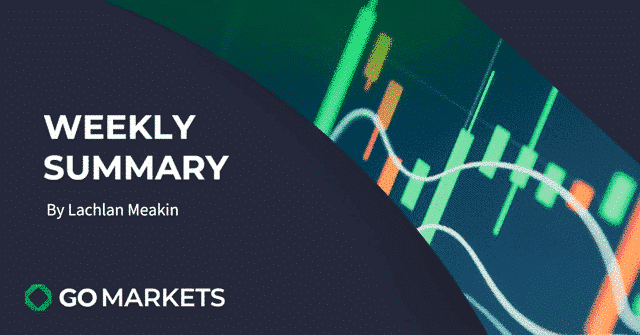

Equity markets US markets dropped sharply overnight as inflation fears returned on the back of Treasury yields hitting their highest levels in more than a year. Investors are concerned the Federal Reserve will allow inflation to accelerate, after Wednesday’s policy meeting where they reaffirmed their commitment to easy money policies. As seen previously the hardest hit stocks were the growth small caps and Tech companies on the Russell and NASDAQ, as traders rotated out of these sectors into traditional value stocks tracked by the Dow Jones index.
The Dow did touch all time highs during the session before fading in the afternoon. Dow Jones down 153 (0.46%) NASDAQ down 409 (3.02%) S&P 500 down 58 (1.48%) Russell 2000 down 69 (2.94%) Source: Yahoo Finance The Australian equity market had a choppy week, mirroring its US counterparts as economic enthusiasm battled with fears of rising interest rates. The ASX 200 dropped yesterday with the sell-off continuing today as much better than forecast employment figures saw market expectations of rising interest rates coming sooner than previously expected.
Source: Yahoo Finance World equity indices are mostly flat for the week as markets see sawed between all time highs and steep declines. Evidence of rotation from Growth and momentum stocks into traditional value stocks in the US is evident from Dow's outperformance of the NASDAQ and S&P 500. The ASX 200 also dropped over the week as rising Aussie and US bond yields plus a strong employment report had investors reassessing predictions of when the RBA would start a tightening cycle on rates.
Source: Bloomberg Forex markets FX markets saw a mostly stronger US dollar against most major currencies. Rising bond yields in the US have mostly driven this move higher - higher interest rates make the US dollar a more attractive investment than its counterparts. Traditional safe haven currencies the Swiss Franc and Japanese Yen were the only major currencies to outperform the US dollar this week, on a choppy performance in equity markets.
Source: Bloomberg Commodities Gold Spot gold (XAUUSD) was the other safe haven that rallied against the US dollar, being modestly up for the week at the time of writing. Despite a mostly rising US Dollar, gold ground higher on inflation fears spurred by rising rates in bond yields. Source: GO MT4 Oil US crude prices dropped sharply this week as US crude found stiff resistance around the $67 a barrel price level after a recent strong run up.
US Crude plunged more than 9% in yesterday’s session at one point, on concerns new COVID lockdowns in Europe will sap demand, and whether the recent run up is justified with the current progress of world economic recovery. Source: GO MT4 Bitcoin Bitcoin gapped on the Monday open to set a record price above $60k US per token. This after an extremely volatile week which saw the cryptocurrency ranging from 53k – 60k Whether the cryptocurrency has run out of steam at these levels or is preparing for another push higher remains to be seen.
Source: GO MT4 Monday, 22 March 2021 Indicative Index Dividends Dividends are in Points ASX200 WS30 US500 US2000 NDX100 CAC40 STOXX50 0.081 0 0.01 0.024 0 0.098 0 ESP35 ITA40 FTSE100 DAX30 HK50 JP225 INDIA50 0 1.454 0 0 0 0 1.072


Going into the month’s last day of trading, Global markets have performed well despite a sell off this week. Continued hopes that we’re on a path to economic recovery, with COVID vaccines rolling out and the subsequent drop in cases, have supported markets and drawn in investors. Global Equities Major US Indices all saw record highs, with the Dow and S&P500 finishing the month strongly.
The tech heavy NASDAQ also hit all-time highs before selling off as investors rotated into traditional cyclical stocks. Tech stocks such as Amazon, Peloton and DocuSign, which all performed well during COVID lockdown measures, dragged down the index as lockdowns started to ease all over the world. European, UK, Asian and Australian equity markets also performed strongly.
Source: Bloomberg US Markets February saw record highs earlier in the month as COVID vaccinations rolled out out and the Federal Reserve re-iterated its commitment to accommodative conditions until employment and inflation targets are met. Despite these assurances from the Fed there's been a spike in bond yields which has caused concern for investors in the last days of the month, resulting in a significant sell off in US markets overnight. Investors will be watching this coming into March as any continuation of rising yields will be a negative for equities.
Asian Markets Asian markets performed strongly in February with the Nikkei being the strongest performer, breaking above 30000 - a level not seen since the bubble era of the 80s/90s. Source: Bloomberg Hong Kong’s Hang Seng also continued its impressive run. HKEX has seen record volumes on Chinese firms finding a new home there over concerns they'd be booted from US exchanges.
HKEX is now the world's biggest bourse by market value, easily beating rival bourses in London and the US. Australia The ASX 200 has rallied over 3% to date in February. Persistently high commodity prices, an extension in the RBA’s QE bond buying program, and a recovering labour market all supported Aussie equities.
COVID vaccinations starting also gave investors optimism for a continuing economic recovery. Source: tradingeconomic.com FX market February saw a mostly weaker US dollar, with the greenback only outperforming safe haven currencies the Swiss Franc and Japanese yen. With equity markets rallying and record commodity prices, risk and commodity backed currencies outperformed, with the AUDUSD breaking decisively through its 2021 resistance level of 78c US.
Source: Bloomberg British Pound Despite being neither a risk on nor commodity currency the British pound strongly rallied this month on impressive COVID vaccination progress. The pound hit its highest level against the US dollar in nearly three years, amid rising optimism about an end to lockdown in the UK. Australian Dollar The Australian Dollar was the top performing major currency in February.
This despite a dip at the start of the month, when the RBA somewhat surprised the market with an announcement of the extension of the 100 billion bond buying program. Strong signs of recovery in the local labour market, Chinese demand for commodities which are near record highs, and the status of AUD being a 'risk on' currency all helped AUDUSD break through the 78c US level. Analysts at ANZ and CBA expect the Australian dollar to trade as high as 82 US cents by the end of the year.
Source: GO MT4 Bitcoin Bitcoin again proved how volatile it can be with wild swings during the month. The cryptocurrency gyrated wildly from 32k USD at the start of the month, hitting an all-time high above 57K before selling off to be around 47k at the time of writing. Increased optimism in the institutionalising of Bitcoin as big players such as Morgan Stanley, Bridgewater capital, BNY Mellon and Tesla announced Bitcoin investments drove the price higher as momentum traders jumped on board.
The party was somewhat spoilt by comments from Treasury secretary Janet Yellen who labelled Bitcoin “an “inefficient” digital currency and one that is often used for illegal transactions” Government regulation and banning of Bitcoin is the biggest fear of traders in this market. Source: GO MT4 Gold Spot Gold prices dropped around 5% in February to date as the precious metal came under serious selling pressure. This drop is despite US dollar weakness; as the economic recovery progresses globally, gold's appeal is waning.
With inflation reportedly low in developed economies gold's other function as an inflation hedge has also waned. XAUUSD is now testing critical support levels that were set late in 2020. Source: GO MT4 Monday, 22 February 2021 Indicative Index Dividends Dividends are in Points ASX200 WS30 US500 US2000 NDX100 CAC40 STOXX50 10.832 8.224 0.097 0.029 0 0 0 ESP35 ITA40 FTSE100 DAX30 HK50 JP225 INDIA50 0 0 0 0 0 0 0.718


在全球碳中和背景以及各地政策的支持下,新能源汽车行业实现了快速发展,渗透率不断提高,越来越多的企业逐浪新能源电车领域,竞争格局不断加剧。随着新兴汽车品牌不断提高竞争力,传统老牌车企也开始向新能源汽车领域转型。其中,比亚迪更是停止旗下燃油汽车的整车生产业务,将专注于纯电动和插电式混合动力车型的业务。目前已有多家新能源车企披露3月销量成绩单,总体来看新能源汽车市场持续回暖。其中,比亚迪3月新能源汽车销量同比接近翻倍, 2023年3月其新能源汽车销量207,080辆,同比增长97.4%; 本年累计销量552,076辆,同比增长92.81%。其中宋PLUS车系3月销售32510辆,2023年第一季度总销售量超过10万辆,向SUV市场新格局展现了其强大的实力。在比亚迪汽车中,宋家族一直是销量的中坚力量,该家族贡献了公司1/4的总销量。宋家族包括三种车型:宋PLUS、宋PRO和宋MAX,其中宋PLUS是最畅销的车型。

近期,比亚迪也公布了2022年度全年业绩和第四季度财务报告。根据财报数据显示,比亚迪2022年的营业收入为4240.61亿元,同比增长96.20%;归属于上市公司股东的净利润为166.22亿元,同比增长445.86%;扣除非经常性损益的净利润为156.38亿元,同比增长1146.42%。从数据来看,比亚迪在过去一年的表现十分优异,业绩大丰收,营收和利润均取得了巨大增长。其业绩增长主要来源于“量”与“价”两个方面因素。销量的突破,2022 年公司实现销量 180.25 万辆,同比增长149.88%;高端款式车的销量增长,汉/唐系列 2022 销量分别为 27.4、15.1 万辆,同比132.9%和178.3%。数次调价给收入端带来增长动力,在上一年里,王朝系列和海洋系列的汽车型号进行了三次调价,涨幅累计在0.7-1.9万元左右;这一提价策略有助于缓解上游原材料价格上涨所带来的成本压力。
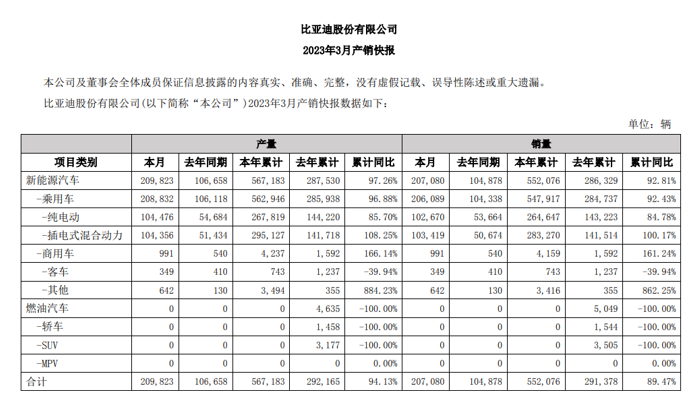
比亚迪在上周五通过微博分享了一张“海鸥”新车型的图片。该车型为电动掀背车,价格实惠,预计采用新型电池技术。据悉,该车将在第二季度推出,成为城市居民的优选之一。据媒体报道,这款车型比比亚迪目前最小的车型“海豚”更小,预计起价不到10万元人民币(约合1.5万美元),市场上10万元以下的车型竞争日趋激烈。比亚迪在新能源汽车业务领域有着良好的景气度和广阔的成长空间,再加上逆全球化的背景下,比亚迪在垂直产业链上的优势明显,无论是在产量还是价格上都占据着优势。综合来看,对比亚迪在未来的表现还是非常看好的。毫无疑问,新能源汽车产业即将进入市场化竞争阶段,补贴退出后,技术和品牌将成为核心要素,而行业整合和优胜劣汰的速度将会加快。展望新能源汽车市场,预计4月上海车展将迎来众多新车的密集亮相,其中可能包括蔚来ET5猎装版、轿跑SUVEC7、小鹏G6、极氪X等。高质量的供给快速推出,有望带来新的势力并长期向好。免责声明:GO Markets分析师或外部发言人提供的信息基于其独立分析或个人经验。所表达的观点或交易风格仅代表其个人;并不代表GO Markets的观点或立场。联系方式:墨尔本 03 8658 0603悉尼 02 9188 0418中国地区(中文) 400 120 8537中国地区(英文) +248 4 671 903作者:Yiduo Wang | GO Markets 助理分析师


热门话题就在前几周,市场新闻还充斥着美国银行出问题,或者瑞士银行出问题的新闻。正常咱们读者包括我本人,被这样的新闻冲击了1个月,心里一定会觉得,这市场不好,肯定应该是股市下跌,肯定应该是大宗商品下跌,美元和其他避险资产上涨。但是过去几天的现实却啪啪地打脸:不但股市没有出现继续下跌,从美国到澳洲,居然连续出现了上涨。而且关键是所有的风险资产,例如非美货币和数字货币也都在上涨。更为夸张的是,石油价格居然在本周一暴涨了8%。

我的第一反应就是:是中东打仗了?还是哪个银行又挂了?找了一圈,没找到类似的新闻。再仔细一看,发现不是银行出事,而是供应商在搞事情:欧佩克石油输出组织在上周末意外宣布将会从5月开始每天减少116万桶的石油供应,给出的理由相当的搞笑:为了稳定当前的油价走势。先来说说书本知识:我们知道石油这个东西自从18世纪工业革命以来至今,就是世界各国经济的血液。油价的高低直接会影响到各国经济发展的成本,以及最终影响到工业制成品的价格,从而间接的影响到物价走势。因为在所有的生产链中,都离不开石油及其相关产品的价格变化,从汽油柴油,航空煤油,到聚乙烯,以及一些塑料制成品,其原料都和石油价格直接相关。油价成本一旦上涨30%,将会导致最终厂家的出厂价格也会有巨大的影响。或者换一种说法,油价上涨之后,工厂的生产成本,和服务行业的运行成本都会相应增加,因此最终给消费者的价格也会提高。这样一来,物价就会被整个推上去。所以,石油价格如果上涨, 轻则影响经济,重则导致通货膨胀。当然了,油价上涨最直接的受益者是谁?当然就是产油国了。虽然产油国同意一起每天减产116万桶,这每天的损失似乎不小。但是相比于油价整体上涨8%来说,依然是笔非常划算的买卖。更重要的是,如此一来也更加加大了产油国对于其他国家的重要性,因为他们控制着,或者部分控制着全世界物价上涨的砝码。事实上油价从2022年7月开始到现在几乎都是在下跌,这也从侧面说明了美联储加息之后对于经济活动的影响在不断增加。从下面的图形里我们可以看到,油价从2022年5月高峰时期的120美元,到上个月最低石油的不到68美元,其下跌幅度超过了40%以上。因此即便过去几天的大幅反弹,从长期走势来看,依然没有得到有效的反转。
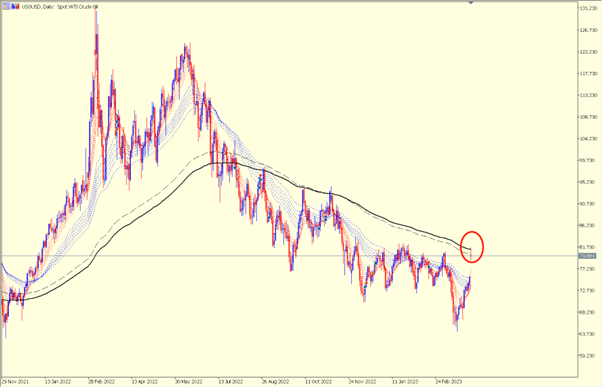
好了,现在问题来了,从2022年美国加息,到我们澳洲自己过去的10次加息,都是为了啥?还不是为了控制物价,压制通货膨胀?结果来看,虽然物价有没有压下去还不能确认,但是可以肯定,油价是压下去了40%。更重要的一点:俄罗斯也是世界产油大国。因此自从2022年初和乌克兰的战争爆发以来,美国也从多方面在发动经济制裁,其中就包括了石油。然而,虽然美国使用不同的办法把油价从120美元在短短4个月时间里就成功的压制到了80美元以下,但是也同时得罪了美国在中东最大的盟友——沙特。其实我们从沙特过去一年和美国之间爆出来的新闻就可以看出两国关系出现了问题。首先就是当俄乌战争爆发以后,沙特公开反对立即增产来弥补因为禁止俄罗斯石油导致的供应缺口。接着就是今年沙特极其意外的和仇敌伊朗宣布建交,以及现在再次意外宣布减产石油来稳定油价。种种行为都在宣示着其对于美国牺牲其利益做法的严重不满。美国的加息所导致的油价下跌严重的影响到了沙特和其他产油国的经济收入。而且这个下跌可不是一点半点,而是40%。试想一下,要是你的年收入突然暴跌了40%,你会不会抓狂?如果你知道是另一个人的行为直接导致你的收入下跌,你会不会怨恨在心?虽然我不知道沙特王储的真实想法,但是他的做法就是让市场解读其对于美国很多行为的不满,以及其为了维护国家利益的决心。

但是我在最后想说的是:虽然任何商品的价格取决于供应,和需求端两个方面。但是从历史经验来看,商品的长期价格走势还是由消费者的需求总量所产生的影响更大。这么说吧,如果一件东西客户抢着要,那自然价格就上涨。但是如果消费者不要了,或者没有以前那么需要了,那即使东西产量下降了,甚至即使打折了,也不会有太大的兴趣。那石油也是一样。未来油价要上涨的关键,还是需要看中国今年下半年对于石油的需求能否回到之前的水平。如果没有,那再多的减产,也只能是一个短期作用而已。长期需求不足导致的下跌不会改变。免责声明:GO Markets分析师或外部发言人提供的信息基于其独立分析或个人经验。所表达的观点或交易风格仅代表其个人;并不代表GO Markets的观点或立场。联系方式:墨尔本 03 8658 0603悉尼 02 9188 0418中国地区(中文) 400 120 8537中国地区(英文) +248 4 671 903作者:Mike Huang | GO Markets 销售总监

